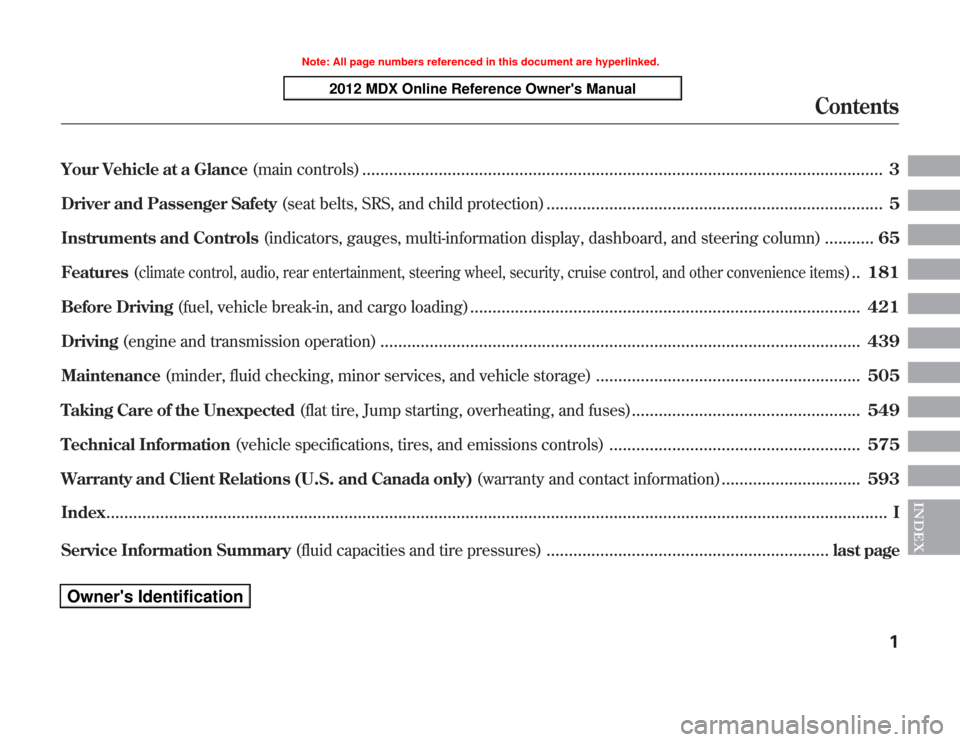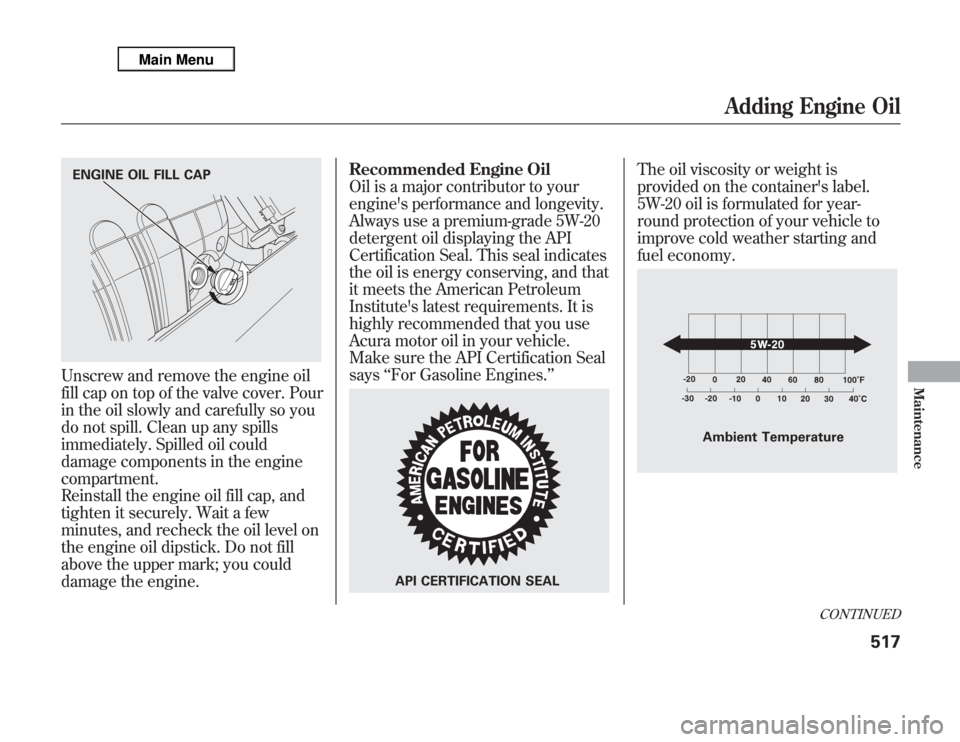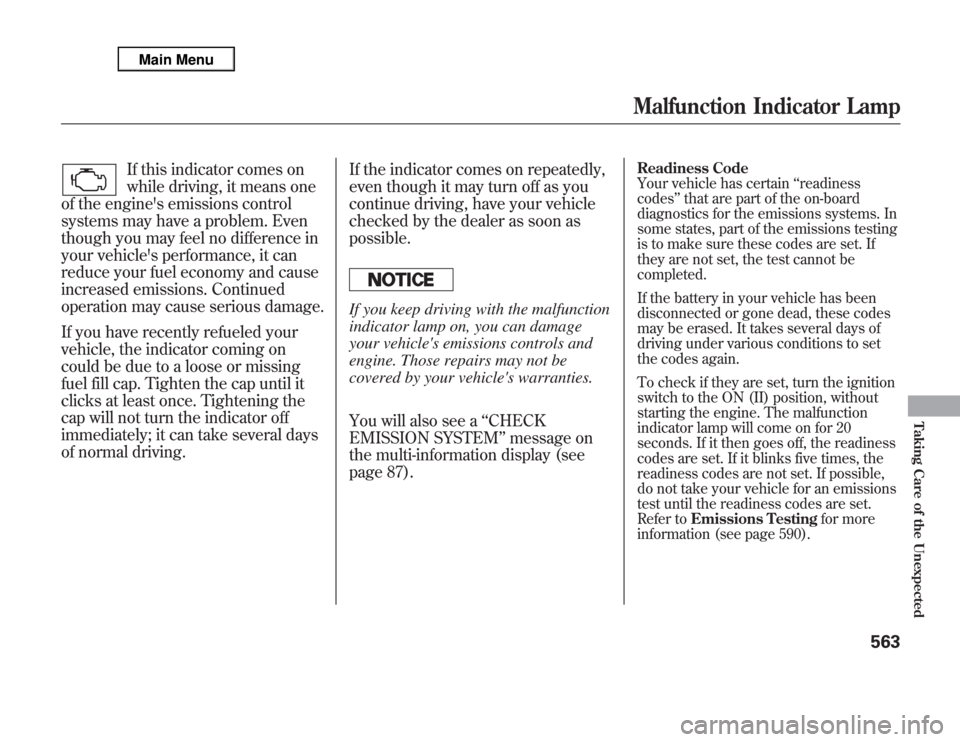fuel cap Acura MDX 2012 Owner's Manual
[x] Cancel search | Manufacturer: ACURA, Model Year: 2012, Model line: MDX, Model: Acura MDX 2012Pages: 621, PDF Size: 11.15 MB
Page 8 of 621

Your Vehicle at a Glance(main controls)
....................................................................................................................
3
Driver and Passenger Safety(seat belts, SRS, and child protection)
...........................................................................
5
Instruments and Controls(indicators, gauges, multi-information display, dashboard, and steering column)
...........
65
Features(
climate control, audio, rear entertainment, steering wheel, security, cruise control, and other convenience items
)..
181
Before Driving(fuel, vehicle break-in, and cargo loading)
.......................................................................................
421
Driving(engine and transmission operation)
...........................................................................................................
439
Maintenance(minder, fluid checking, minor services, and vehicle storage)
...........................................................
505
Taking Care of the Unexpected(flat tire, Jump starting, overheating, and fuses)
...................................................
549
Technical Information(vehicle specifications, tires, and emissions controls)
........................................................
575
Warranty and Client Relations (U.S. and Canada only)(warranty and contact information)
...............................
593
Index
..............................................................................................................................................................................
I
INDEX
Service Information Summary(fluid capacities and tire pressures)
...............................................................
last page
Contents
1
Page 9 of 621

Contents
A convenient reference to the
sections in this manual.
Your Vehicle at a Glance
A quick reference to the main
controls in your vehicle.
Driver and Passenger Safety
Important information about the
proper use and care of your vehicle's
seat belts, an overview of the
supplemental restraint system, and
valuable information on how to
protect children with child restraints.
Instruments and Controls
Explains the purpose of each
instrument panel indicator and
gauge, and how to use the controls
on the dashboard and steering
column.
Features
How to operate the climate control
system, the audio system, rear
entertainment system, and other
convenience features.Before Driving
What gasoline to use, how to break-
in your new vehicle, and how to load
luggage and other cargo.
Driving
The proper way to start the engine,
shift the transmission, and park; plus
what you need to know if you're
planning to tow a trailer.
Maintenance
The Maintenance Minder™shows
you when you need to take your
vehicle to the dealer for maintenance
service. There is also a list of things
to check and instructions on how to
check them.
Taking Care of the Unexpected
This section covers several problems
motorists sometimes experience, and
details how to handle them.Technical Information
ID numbers, dimensions, capacities,
and technical information.
Warranty and Client Relations
(U.S. and Canada only)
A summary of the warranties
covering your new vehicle, and how
to contact us for any reason. Refer to
your warranty manual for detailed
information.
Index
Service Information Summary
A summary of the information you
need when you pull up to the fuel
pump.Overview of Contents2
Page 428 of 621

Before you begin driving your
vehicle, you should know what
gasoline to use and how to check the
levels of important fluids. You also
need to know how to properly store
luggage or packages. The
information in this section will help
you. If you plan to add any
accessories to your vehicle, please
read the information in this section
first.Break-in Period
...........................
422
Fuel Recommendation
................
422
Service Station Procedures
.........
424
Refueling
.................................
424
Tighten Fuel Cap Message
.....
425
Opening and Closing the
Hood
...................................
426
Oil Check
................................
427
Engine Coolant Check
............
427
Fuel Economy
.............................
428
Accessories and
Modifications
..........................
431
Carrying Cargo
...........................
433
Before Driving
421
Before Driving
Page 431 of 621

Refueling1. Park with the driver's side closest
to the service station pump.
2. Open the fuel fill door by pressing
the button in the driver's door. (To
open the fuel fill door manually,
see page 572.)
3. Remove the fuel fill cap slowly.
You may hear a hissing sound as
pressure inside the tank equalizes.
Place the cap in the holder on the
fuel fill door.
4. Stop filling the tank after the fuel
nozzle automatically clicks off. Do
not try to‘‘top off’’the tank. Leave
some room for the fuel to expand
with temperature changes.If the fuel nozzle keeps clicking off
even though the tank is not full,
there may be a problem with your
vehicle's fuel vapor recovery system.
The system helps keep fuel vapor
from going into the atmosphere. Try
filling at another pump. If this does
not fix the problem, consult your
dealer.
Gasoline is highly flammable
and explosive. You can be
burned or seriously injured
when handling fuel.●
Stop the engine, and keep
heat, sparks, and flame
away.
●
Handle fuel only outdoors.
●
Wipe up spills immediately.
Push
FUEL FILL CAP
TETHER
HOLDER
Service Station Procedures424
Page 432 of 621

5. Screw the fuel fill cap back on until
it clicks at least once. If you do not
properly tighten the cap, you will
see a‘‘TIGHTEN FUEL CAP’’
message on the multi-information
display (see right column on this
page), and the malfunction
indicator lamp may also come on
(see page 563).
6. Push the fuel fill door closed until
it latches.Tighten Fuel Cap Message
Your vehicle's on board diagnostic system
will detect a loose or missing fuel fill cap as
an evaporative system leak. The first time a
leak is detected a‘‘TIGHTEN FUEL CAP’’
message appears on the multi-information
display. Turn the engine off, and confirm the
fuel fill cap is installed. If it is, loosen it, then
retighten it until it clicks at least once. The
message should go off after several days of
normal driving once you tighten or replace
the fuel fill cap. To scroll to another message,
press the INFO button. The‘‘TIGHTEN
FUEL CAP’’message will appear each time
you restart the engine until the system turns
the message off.
If the system still detects a leak in
the vehicle's evaporative emissions
system, the malfunction indicator
lamp (MIL) comes on. If the fuel fill
cap was not already tightened, turn
the engine off, and check or
retighten the fuel fill cap until it
clicks at least once. The MIL should
go off after several days of normal
driving once the cap is tightened or
replaced. If the MIL does not go off,
have your vehicle inspected by a
dealer. For more information, see
page 563.Service Station Procedures
425
Before Driving
Page 524 of 621

Unscrew and remove the engine oil
fill cap on top of the valve cover. Pour
in the oil slowly and carefully so you
do not spill. Clean up any spills
immediately. Spilled oil could
damage components in the engine
compartment.
Reinstall the engine oil fill cap, and
tighten it securely. Wait a few
minutes, and recheck the oil level on
the engine oil dipstick. Do not fill
above the upper mark; you could
damage the engine.Recommended Engine Oil
Oil is a major contributor to your
engine's performance and longevity.
Always use a premium-grade 5W-20
detergent oil displaying the API
Certification Seal. This seal indicates
the oil is energy conserving, and that
it meets the American Petroleum
Institute's latest requirements. It is
highly recommended that you use
Acura motor oil in your vehicle.
Make sure the API Certification Seal
says‘‘For Gasoline Engines.’’
The oil viscosity or weight is
provided on the container's label.
5W-20 oil is formulated for year-
round protection of your vehicle to
improve cold weather starting and
fuel economy.
ENGINE OIL FILL CAP
API CERTIFICATION SEAL
Ambient Temperature
CONTINUED
Adding Engine Oil
517
Maintenance
Page 570 of 621

If this indicator comes on
while driving, it means one
of the engine's emissions control
systems may have a problem. Even
though you may feel no difference in
your vehicle's performance, it can
reduce your fuel economy and cause
increased emissions. Continued
operation may cause serious damage.
If you have recently refueled your
vehicle, the indicator coming on
could be due to a loose or missing
fuel fill cap. Tighten the cap until it
clicks at least once. Tightening the
cap will not turn the indicator off
immediately; it can take several days
of normal driving.If the indicator comes on repeatedly,
even though it may turn off as you
continue driving, have your vehicle
checked by the dealer as soon as
possible.
If you keep driving with the malfunction
indicator lamp on, you can damage
your vehicle's emissions controls and
engine. Those repairs may not be
covered by your vehicle's warranties.
You will also see a‘‘CHECK
EMISSION SYSTEM’’message on
the multi-information display (see
page 87).
Readiness Code
Your vehicle has certain‘‘readiness
codes’’that are part of the on-board
diagnostics for the emissions systems. In
some states, part of the emissions testing
is to make sure these codes are set. If
they are not set, the test cannot be
completed.
If the battery in your vehicle has been
disconnected or gone dead, these codes
may be erased. It takes several days of
driving under various conditions to set
the codes again.
To check if they are set, turn the ignition
switch to the ON (II) position, without
starting the engine. The malfunction
indicator lamp will come on for 20
seconds. If it then goes off, the readiness
codes are set. If it blinks five times, the
readiness codes are not set. If possible,
do not take your vehicle for an emissions
test until the readiness codes are set.
Refer toEmissions Testingfor more
information (see page 590).Malfunction Indicator Lamp
563
Taking Care of the Unexpected
Page 585 of 621

Dimensions
Length 191.6 in (4,867 mm)
Width 78.5 in (1,994 mm)
Height 68.2 in (1,733 mm)
Wheelbase 108.3 in (2,750 mm)
Track Front 67.7 in (1,720 mm)
Rear 67.5 in (1,715 mm)
Weights
Gross vehicle weight rating See the tire information label
attached to the driver's doorjamb.
Gross combined weight
ᤳ1
rating (GCWR)10,053 lbs (4,560 kg)
ᤳ1: The GCWR must be reduced 2 percent for every 1,000 feet (305
meters) of elevation.
Air Conditioning
Refrigerant type HFC-134a (R-134a)
Charge quantity 21.2-22.9 oz (600-650 g)
Lubricant type ND-OIL 8
Seating Capacities
Total 7
Front 2
Second 3
Third 2Capacities
Fuel tank Approx.
21.00 US gal (79.5 L)
Engine
coolantChange
ᤳ1
1.93 US gal (7.3 L)
Total 2.43 US gal (9.2 L)
Engine oil Change
ᤳ2
4.5 US qt (4.3 L)
Including
filter
Without
filter4.2 US qt (4.0 L)
Total 5.3 US qt (5.0 L)
Automatic
transmission
fluidChange 3.3 US qt (3.1 L)
Total 8.5 US qt (8.0 L)
Rear
differential
fluidChange 2.6 US qt (2.5 L)
Total 3.0 US qt (2.8 L)
Transfer
assembly
fluidChange 0.4 US qt (0.4 L)
Total 0.4 US qt (0.4 L)
Windshield
washer
reservoirU.S. vehicles 4.2 US qt (4.0 L)
Canadian
vehicles6.1 US qt (5.8 L)
ᤳ1: Including the coolant in the reserve tank and that remaining in the
engine
Reserve tank capacity:
0.18 US gal (0.7 L)
ᤳ2: Excluding the oil remaining in the engine
Specifications578
Page 595 of 621

Onboard Refueling Vapor
Recovery
The onboard refueling vapor
recovery (ORVR) system captures
the fuel vapors during refueling. The
vapors are adsorbed in a canister
filled with activated carbon. While
driving, the fuel vapors are drawn
into the engine and burned off.
Exhaust Emissions Controls
The exhaust emissions controls
include four systems: PGM-FI,
ignition timing control, exhaust gas
recirculation, and three way catalytic
converter. These four systems work
together to control the engine's
combustion and minimize the
amount of HC, CO, and NOx that
come out the tailpipe. The exhaust
emissions control systems are
separate from the crankcase and
evaporative emissions control
systems.
PGM-FI SystemThe PGM-FI system uses sequential
multiport fuel injection. It has three
subsystems: air intake, engine
control, and fuel control. The
powertrain control module (PCM)
uses various sensors to determine
how much air is going into the
engine. It then controls how much
fuel to inject under all operating
conditions.Ignition Timing Control SystemThis system constantly adjusts the
ignition timing, reducing the amount
of HC, CO, and NOx produced.Exhaust Gas Recirculation (EGR)
SystemThe exhaust gas recirculation (EGR)
system takes some of the exhaust
gas and routes it back into the intake
manifold. Adding exhaust gas to the
air/fuel mixture reduces the amount
of NOx produced when the fuel is
burned.
Three Way Catalytic ConverterThe three way catalytic converter is
in the exhaust system. Through
chemical reactions, it converts HC,
CO, and NOx in the engine's exhaust
to carbon dioxide (CO
2), nitrogen
(N
2), and water vapor.
Replacement Parts
The emissions control systems are
designed and certified to work
together in reducing emissions to
levels that comply with the Clean Air
Act. To make sure the emissions
remain low, you should use only new
Acura replacement parts or their
equivalent for repairs. Using lower
quality parts may increase the
emissions from your vehicle.
The emissions control systems are
covered by warranties separate from
the rest of your vehicle. Read your
warranty manual for more
information.
Emissions Controls588
Page 609 of 621

Emergency Flashers
..................
132
Emergency Towing
....................
572
Emissions Controls
....................
587
Emissions Testing
......................
590
Engine
Adding Engine Coolant
...........
520
Check Starting System
............
443
Coolant Temperature Gauge
....
78
If it Won't Start
........................
557
Malfunction Indicator
Lamp
.............................
69, 563
Oil Life Indicator
.....................
507
Oil Pressure Indicator
.......
69, 562
Oil, What Kind to Use
.............
517
Overheating
............................
560
Specifications
..........................
579
Speed Limiter
..........................
446
Starting
...................................
442
Engine Coolant
..........................
520
Ethanol in Gasoline
....................
422
Evaporative Emissions
Controls
..................................
587
Exhaust Fumes
............................
61
Exhaust Gas Recirculation
System
...................................
588Expectant Mothers, Use of Seat
Belts by
....................................
19
F
Fan, Interior
...............................
185
Features
.....................................
181
Filters
Dust and Pollen
.......................
534
Oil
...........................................
518
Flashers, Hazard Warning
.........
132
Flat Tire, Changing a
.................
551
Floor Mats
.................................
535
Fluids
Automatic Transmission
.........
523
Brake
......................................
525
Location
..................................
515
Power Steering
........................
526
Windshield Washer
.................
522
FM Stereo Radio
Reception
................................
303
Fog Lights
..................................
130
Folding the Second Seat
.............
153
Folding the Third Seat
...............
154
Four-way Flashers
......................
132Front Airbags
.........................
10, 30
Front Seat
..................................
149
Adjusting
.................................
149
Air Ventilation
.........................
158
Heaters
...................................
157
Fuel
............................................
422
Economy
.................................
428
Fill Door and Cap
....................
424
Gauge
......................................
78
Low Fuel Indicator
...................
77
Octane Requirement
...............
422
Opening the Fuel Fill Door
Manually
.............................
572
Reserve Indicator
.....................
77
Tank, Filling the
......................
424
Tighten Fuel Cap
....................
425
Fuel Economy
............................
428
Fuses, Checking the
..................
566
G
Gas Mileage, Improving
.............
429
Gasoline
.....................................
422
Gauge
......................................
78
Low Fuel Indicator
...................
77
IndexIV